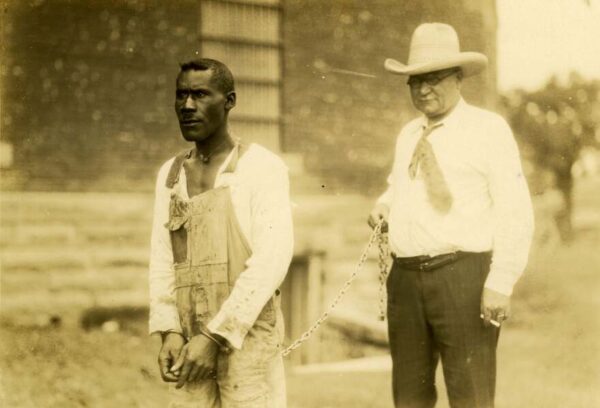In 1930, at the height of the Jim Crow era, a thriving Black business district existed in Sherman, Texas. Businesses such as law offices, barbershops, beauty salons, a funeral parlor and other shops were present to serve the Black community in the Texoma region town straddling the Oklahoma border.

And then the Black business district, along with the Grayson County Courthouse, was destroyed after George Hughes, a Black farm worker who was arrested on charges of raping the wife of his boss after trying to collect the $6 he was due for his labor. During Hughes’ trial, a mob of white men set the courthouse ablaze and Hughes retreated to a vault inside the building. When the mob broke into the vault after fire went out they found Hughes dead of suffocation. His body was hanged from a lamppost before the mob destroyed several Black businesses. Days later, the National Guard stepped in. This event came to be known as the Sherman Riot of 1930.
Almost 92 years later, local officials are partnering with Montgomery, Alabama-based Equal Justice Initiative, NAACP, and the Sherman Interdenominational Ministerial Alliance to honor Black businesses destroyed during the Sherman Riot of 1930 with a historical marker. But it was a struggle to push for the marker.
“History is history, and one of the things that we understand from back in those days, things like this happened,” Assistant City Manager Terrence Steele told News 12. “I think Sherman is a community that recognizes it happened in our community and we want to make sure nothing like this happens again.”
“In the Jim Crow South, to have Black lawyers and Black doctors, civil rights attorneys, undertakers, it was a business-class area,” historian Melissa Thiel told The Herald Democrat of the Sherman community. “A lot of the Black workers at the time were working class. They were farm laborers like George Hughes. So, to have a business class here was notable. Not all cities had that.”
Thiel was the force behind the marker. She came up with the idea for the marker a year ago and proposed it to the City Council. She wasn’t expecting the resistance she received from some of the town’s white leaders.
“I picked a doozy,” Thiel told The Washington Post last summer. “I was naive, and I didn’t think the pushback I’d get would get to this level.”
Thiel ultimately reached out to the then-chairwoman of the Grayson County Historical Commission, Teddie Ann Salmon, in June 2020. The idea for the marker and was given a green light. Then in November, she was informed Salmon had a problem with the wording on the plaque, and the marker was not fully approved.
“I have a problem with the word ‘lynching,’” Salmon said, arguing that technically Hughes had not been lynched as he was already dead when he was hanged. Thiel pushed back that the definition of lynching does not always involve a hanging. Still, the marker was stalled until Thiel hit the media circuit, giving interviews and launching a Facebook page and urged residents to get involved. Ultimately, the commission approved the marker on March 9, 2021.
But the marker still has not been fully approved by the city.
“The marker has to get three approvals. We have received two of three,” Thiel explained to Finurah. “The first approval came from the Grayson County Historical Commission on March 9, 2021. The second approval has been the hardest so far. We had to get approval from Judge Bill Magers and the four commissioners to put the marker at the courthouse. We sent 22 requests to be on the commissioners court agenda over a six-month period. Finally on Oct. 12, 2021, the marker was out on the agenda and approved to be placed at the courthouse.”
There is still one more hurdle for the marker. “The third and final approval comes from the Texas Historical Commission. We submitted our application as an undertold marker and we will find out if we are selected by the state on Feb 3rd,” says Thiel.

If the final approval goes through, Thiel estimates the marker will erected in the summer of 2023.
The plaque will be located at the corner of Walnut and Mulberry streets, which was the center of Sherman’s Black business district. The marker will share details of the Black business district, events leading up to the lynching of George Hughes on Mulberry Street and the riots that unfolded as a result.
Thiel spoke of the pushback she got against placing a marker in the site of the lynching.“It’s not just the racist violence that some people don’t want to confront,” she told The Washington Post.
“They also don’t want to confront the long calls for justice.” The partnership is not only focused on placing a plaque commemorating the incident but is vested in developing opportunities to share the historical significance of Sherman’s Black business district while also strengthening the belief in equality and justice.
Thiel’s push for the marker has sparked other activiism.
“The 1930 Sherman Riot Marker committee goal is to have a Texas Historical Marker placed at the county courthouse. Right now that is the focus but other groups have stepped forward,” Thiel told Finurah.
“Grace United Methodist Church started the George Hughes Memorial Scholarship for Grayson County seniors who plan to attend college,” Thiel added. “The city of Sherman is working with the Equal Justice Initiative to recognize the Black Business District that was once located on Mulberry Street. One thing our committee would like to do is tell the story of the civil rights leader William Durham who lost his law practice during the riot. He went on to work with Thurgood Marshall in Brown vs. Board of Education.
“He is a true hero from Grayson County, and we would love to highlight him. There is nothing official being done yet but we are hopeful we can take on that project after the marker is erected,” she continued.
One questions begs: Will the descendants of the Black business owners receive reparations?
“I honestly do not know the answer to this. I am leading the effort to have a Texas Historical Marker placed at the courthouse to recognized the lynching of George Hughes, the burning of the courthouse, and the destruction of the black business district,” Thiel said. “To my knowledge, reparations have not been discussed at this time.”
Additional reporting by Ann Brown




